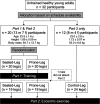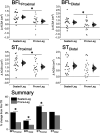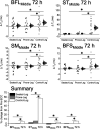Greater Hamstrings Muscle Hypertrophy but Similar Damage Protection after Training at Long versus Short Muscle Lengths
- PMID: 33009197
- PMCID: PMC7969179
- DOI: 10.1249/MSS.0000000000002523
Greater Hamstrings Muscle Hypertrophy but Similar Damage Protection after Training at Long versus Short Muscle Lengths
Abstract
Purpose: We investigated the effects of seated versus prone leg curl training on hamstrings muscle hypertrophy and susceptibility to eccentric exercise-induced muscle damage.
Methods: Part 1: Twenty healthy adults conducted seated leg curl training with one leg (Seated-Leg) and prone with the other (Prone-Leg), at 70% one-repetition maximum (1RM), 10 repetitions per set, 5 sets per session, 2 sessions per week for 12 wk. Magnetic resonance imaging (MRI)-measured muscle volume of the individual and whole hamstrings was assessed pre- and posttraining. Part 2: Nineteen participants from part 1 and another 12 untrained controls (Control-Leg) performed eccentric phase-only leg curl exercise at 90% 1RM, 10 repetitions per set, 3 sets for each of the seated/prone conditions with each leg. MRI-measured transverse relaxation time (T2) and 1RM of seated/prone leg curl were assessed before, 24, 48, and 72 h after exercise.
Results: Part 1: Training-induced increases in muscle volume were greater in Seated-Leg versus Prone-Leg for the whole hamstrings (+14% vs +9%) and each biarticular (+8%-24% vs +4%-19%), but not monoarticular (+10% vs +9%), hamstring muscle. Part 2: After eccentric exercise, Control-Leg had greater increases in T2 in each hamstring muscle (e.g., semitendinosus at 72 h: +52%) than Seated-Leg (+4%) and Prone-Leg (+6%). Decreases in 1RM were also greater in Control-Leg (e.g., seated/prone 1RM at 24 h: -12%/-24%) than Seated-Leg (0%/-3%) and Prone-Leg (+2%/-5%). None of the changes significantly differed between Seated-Leg and Prone-Leg at any time points.
Conclusion: Hamstrings muscle size can be more effectively increased by seated than prone leg curl training, suggesting that training at long muscle lengths promotes muscle hypertrophy, but both are similarly effective in reducing susceptibility to muscle damage.
Copyright © 2020 The Author(s). Published by Wolters Kluwer Health, Inc. on behalf of the American College of Sports Medicine.
Figures








References
-
- Guex K, Millet GP. Conceptual framework for strengthening exercises to prevent hamstring strains. Sports Med. 2013;43(12):1207–15. - PubMed
-
- American College of Sports Medicine . American College of Sports Medicine Position Stand: progression models in resistance training for healthy adults. Med Sci Sports Exerc. 2009;41(3):687–708. - PubMed
-
- Garber CE Blissmer B Deschenes MR, et al. American College of Sports Medicine . American College of Sports Medicine Position Stand: quantity and quality of exercise for developing and maintaining cardiorespiratory, musculoskeletal, and neuromotor fitness in apparently healthy adults: guidance for prescribing exercise. Med Sci Sports Exerc. 2011;43(7):1334–59. - PubMed
-
- Abe T, DeHoyos DV, Pollock ML, Garzarella L. Time course for strength and muscle thickness changes following upper and lower body resistance training in men and women. Eur J Appl Physiol. 2000;81(3):174–80. - PubMed
Publication types
MeSH terms
LinkOut - more resources
Full Text Sources
Medical

